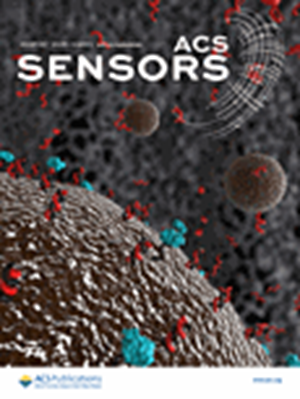用原位形成的水凝胶分离和定量肿瘤来源的外泌体
IF 8.2
1区 化学
Q1 CHEMISTRY, ANALYTICAL
引用次数: 0
摘要
作为肿瘤标志物的外泌体的分离和检测对于肿瘤的早期诊断、治疗监测和机制研究具有重要意义。本研究选择来自乳腺癌细胞的外泌体作为模型靶点,开发了一种基于水凝胶的无洗涤、无酶手持式微型离心方法,有效地分离和检测乳腺癌外泌体。双适体(CD63-T1和EpCAM-T2)被用于特异性识别和捕获乳腺癌外泌体。这种特异性识别通过发夹1与海藻酸盐复合物(H1-Alg)和发夹2 (H2-Cy3)的相互作用,在捕获的外泌体上触发杂交链反应(HCR)纳米结构的形成。Ca2+和海藻酸盐的相互作用使水凝胶在外泌体表面原位形成。随后使用手持式微型离心机进行低速离心,有助于有效地分离外泌体,从而消除了繁琐的洗涤步骤。利用经典的乙二胺四乙酸(EDTA)与Ca2+的螯合反应,水凝胶可以快速切割,使外泌体无酶释放。该方法对特定癌变外泌体的捕获和释放效率分别约为85%和98%。值得注意的是,水凝胶系统分离的外泌体保留了良好的生物活性,使其适合进一步分析和潜在的应用。同时,基于该策略的乳腺癌外泌体的高灵敏度检测也可以实现,检测下限低至3.2 × 103颗粒/mL。本研究为肿瘤源性外泌体的有效分离和检测提供了一种新颖、经济的策略,有助于促进外泌体在后续研究中的应用。本文章由计算机程序翻译,如有差异,请以英文原文为准。

Wash-Free Isolation and Quantification of Tumor-Derived Exosomes via In Situ-Formed Hydrogel
The isolation and detection of exosomes as tumor markers are of vital importance for the early diagnosis, therapeutic monitoring, and mechanistic studies of tumors. Here, exosomes derived from breast cancer cells were chosen as model targets, and a wash-free, enzyme-free, handheld mini centrifugation method based on hydrogels was developed to effectively isolate and detect breast cancer exosomes. Dual aptamers (CD63-T1 and EpCAM-T2) were employed to specifically recognize and capture breast cancer exosomes. This specific recognition triggered the formation of hybridization chain reaction (HCR) nanostructures on the captured exosomes through the interaction of hairpin 1 and the alginate complex (H1-Alg) and hairpin 2 (H2-Cy3). The interaction of Ca2+ and alginate enabled the in situ formation of a hydrogel on the exosome surface. Subsequent low-speed centrifugation using a handheld mini centrifuge facilitated the efficient isolation of the exosomes, thereby eliminating the need for tedious washing steps. Utilizing the classical chelation reaction of ethylene diamine tetraacetic acid (EDTA) with Ca2+, the hydrogel can be rapidly cleaved for enzyme-free release of exosomes. The method demonstrated excellent capture and release efficiencies of approximately 85% and 98%, respectively, for specific cancerous exosomes. Notably, the exosomes isolated by the hydrogel system retained excellent biological activity, making them suitable for further analysis and potential applications. Meanwhile, the highly sensitive detection of breast cancer exosomes based on this strategy could also be achieved with a lower limit of detection as low as 3.2 × 103 particles/mL. This work provides a novel and cost-effective strategy for the effective isolation and detection of tumor-derived exosomes, which can help to promote the subsequent application of exosomes in research.
求助全文
通过发布文献求助,成功后即可免费获取论文全文。
去求助
来源期刊

ACS Sensors
Chemical Engineering-Bioengineering
CiteScore
14.50
自引率
3.40%
发文量
372
期刊介绍:
ACS Sensors is a peer-reviewed research journal that focuses on the dissemination of new and original knowledge in the field of sensor science, particularly those that selectively sense chemical or biological species or processes. The journal covers a broad range of topics, including but not limited to biosensors, chemical sensors, gas sensors, intracellular sensors, single molecule sensors, cell chips, and microfluidic devices. It aims to publish articles that address conceptual advances in sensing technology applicable to various types of analytes or application papers that report on the use of existing sensing concepts in new ways or for new analytes.
 求助内容:
求助内容: 应助结果提醒方式:
应助结果提醒方式:


